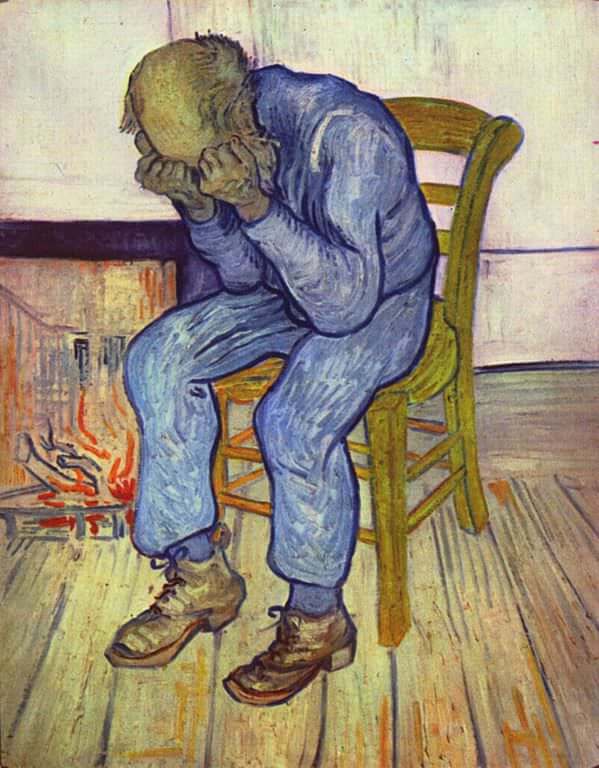At Eternity's Gate, 1890 by Vincent Van Gogh

At Eternity's Gate is an oil painting by Vincent van Gogh that he made in 1890 in Saint-Remy de Provence based on an early lithograph. The painting was completed in early May at a time when he was convalescing from a severe relapse in his health and some two months before his death, generally accepted as a suicide.
The lithograph was based on a pencil drawing Worn Out, one of a series of studies he made in 1882 of a pensioner and war veteran, Adrianus Jacobus Zuyderland, at a local almshouse in The Hauge and itself a reworking of a drawing and watercolor he had made the previous year. The inspiration for Worn Out was Hubert von Herkomer's Sunday at the Chelsea Hospital, an immensely popular print depicting an old war veteran slumped dead that went on to become an acclaimed painting at the Royal Academy, The Last Muster, that van Gogh had seen in 1875 when in England. Van Gogh wrote of his drawing:
Today and yesterday I drew two figures of an old man with his elbows on his knees and his head in his hands. I did it of Schuitemaker once and always kept the drawing, because I wanted to do it better another time. Perhaps I'll also do a lithograph of it. What a fine sight an old working man makes, in his patched bombazine suit with his bald head. ”
Van Gogh's first attempt at the lithograph followed just two days later. He wrote:
It seems to me that a painter has a duty to try to put an idea into his work. I was trying to say this in this print - but I can't say it as beautifully, as strikingly as reality, of which this is only a dim reflection seen in a dark mirror - that it seems to me that one of the strongest pieces of evidence for the existence of 'something on high' in which Millet believed, namely in the existence of a God and an eternity, is the unutterably moving quality that there can be in the expression of an old man like that, without his being aware of it perhaps, as he sits so quietly in the corner of his hearth. At the same time something precious, something noble, that can't be meant for the worms. ... This is far from all theology - simply the fact that the poorest woodcutter, heath farmer or miner can have moments of emotion and mood that give him a sense of an eternal home that he is close to. ”
Later, in a rare expression of his own religious feelings, he wrote expressly about this lithograph and two other drawings also posed by Zuyderland, of an old man reading a Bible and saying grace (below) respectively:
My intention with these two and with the first old man is one and the same, namely to express the special mood of Christmas and New Year. ... Leaving aside whether or not one agrees with the form, it's something one respects if it's sincere, and for my part I can fully share in it and even feel a need for it, at least in the sense that, just as much as an old man of that kind, I have a feeling of belief in something on high even if I don't know exactly who or what will be there.”




















